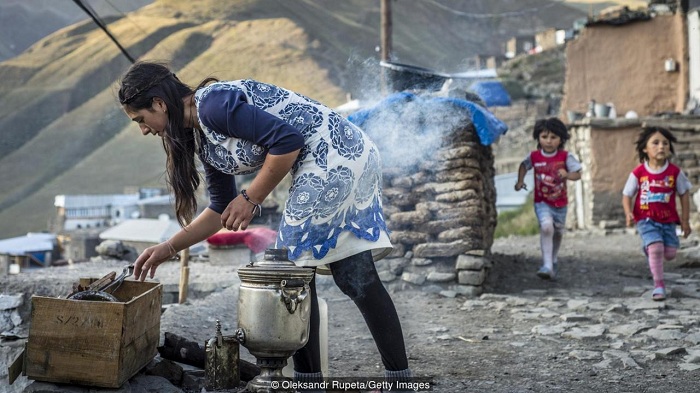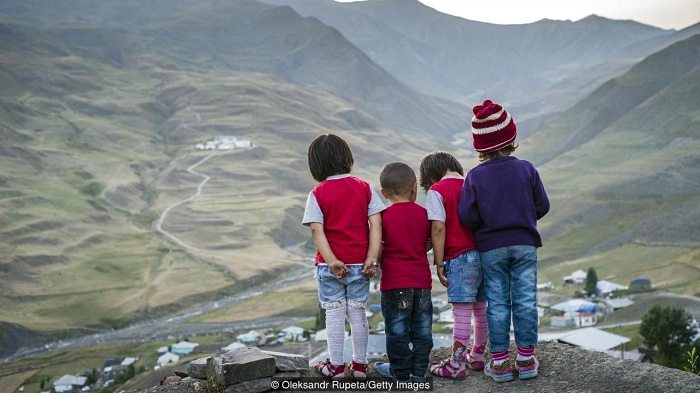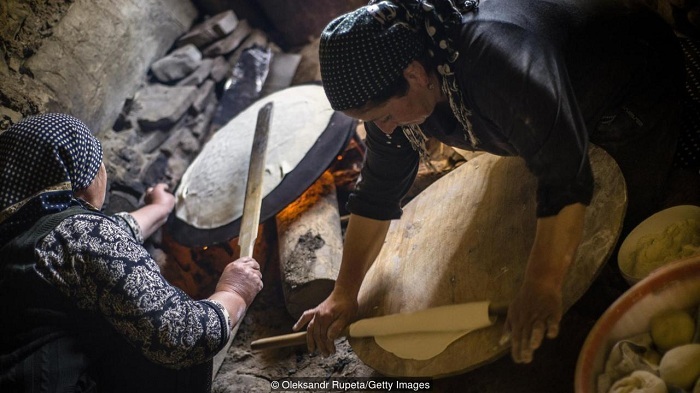Living high up in Azerbaijan’s Greater Caucasus mountains, this community – with its own unique language and traditions – has survived here for centuries.
Azerbaijan’s highest town
Nestled in the Greater Caucasus mountains, Azerbaijan’s highest town of Khinaliq is swirled in mystery and folklore. Archaeological and historical studies indicate that the population’s ancestors moved to the town’s current location around 2,000 years ago. Certain journalists covering the region, however, have conjectured that locals can trace their ancestry back 5,000 years to the Albanian Caucus period. And a local legend names the residents as living descendants of "biblical Noah". (Credit: Oleksandr Rupeta/Getty Images)

Isolation and diversity
The town is located in Azerbaijan’s Quba district, a northeastern region of rich cultural and ethnic diversity. Distinct ethnic communities of Mountain Jews, Tats and Lezgins reside on the mountains’ lower slopes, with Khinalig perched above. All the mountain communities pride themselves on their identities. (Credit: Oleksandr Rupeta/Getty Images)

Stand alone
“They told us ‘we are not Azerbaijani’,” said Getty photographer Oleksandr Rupeta, who visited Khinaliq in September as part of a project documenting the ethnic diversity in Quba. (Credit: Oleksandr Rupeta/Getty Images)

Linguistically unique
Here, the local language is Khinalug, which is exclusive to the area. But Unesco has labelled it severely endangered as only the small number of Khinaliq residents speak it.
However, the language still has hope for survival. Khinaliq’s secondary school – attended by more than 300 local children – offers lessons in Khinalug alongside Azerbaijani and English. (Credit: Oleksandr Rupeta/Getty Images)

Longstanding traditions
The wedding rituals in Khinaliq are strictly mandated by standards passed down through the generations. To commemorate a marriage, the family of the bride flays a bull carcass, stripping the meat. Tea is served during the process.
“Drinking tea [is] like a ritual,” Rupeta said. “It`s very important in their culture.” (Credit: Oleksandr Rupeta/Getty Images)

A constrained diet
The town’s extreme elevation prevents the successful cultivation of many crops. As such, locals grow staples, such as potatoes, and subsist on a simple diet that incorporates a number of simple grains. Townsfolk boast of their unique recipe for lavash, a flatbread commonly found throughout the Caucasus region and Western Asia. It’s baked over fire using a special pan, and the townswomen can prepare a week’s supply in two hours. (Credit: Oleksandr Rupeta/Getty Images)

Opening up
But these traditions, developed over millennia of isolation, are being threatened by increasing modernization. In 2006, the completion of a road between Quba, the region’s capital, and Khinaliq finally connected the town to the world, and more visitors are starting to trickle in. (Credit: Oleksandr Rupeta/Getty Images)

Driven by a harsh climate
Nevertheless, despite the new route, accessibility remains impossible for much of the year. Snow often begins to fall in the area as early as September, and winter temperatures have been known to drop as low as -21C. The stark weather not only blocks the road, but forces shepherds, who form the economic backbone of the community, to relocate their livestock to lower, warmer areas. (Credit: Oleksandr Rupeta/Getty Images)

A resourceful community
The townsfolk burn tezek, a compacted mixture of manure and hay, for warmth. Their homes are built from stones from the nearby Gudyal River; some of them have stood for 200 years and through countless earthquakes. And sheep remain a central part of the lifestyle in Khinaliq, providing food, clothing and trade with other towns. It’s this resourcefulness that has enabled this community to survive for centuries high up in the mountains. (Credit: Oleksandr Rupeta/Getty Images)
















































